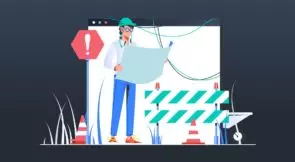Software testing is a critical piece of any successful software development team’s process. We can categorize testing into functional testing and nonfunctional testing. Functional testing focuses on finding bugs, whereas nonfunctional testing focuses on verifying quality.
This post describes how functional testing differs from nonfunctional test cases and how they maximize efficiency and avoid bottlenecks associated with each type of testing during a project.
What’s the Difference Between Functional and Nonfunctional Testing?
Functional testing takes place as a continuous process. Functional testing aims to ensure that all app features work, and thus finding any bugs before release reduces the number of bugs that need to be fixed post-release. Nonfunctional testing occurs after you have released a product to find potential defects or compatibility issues with different systems.
What’s Functional Testing?
Functional testing—also referred to as black box or top-down testing—is software quality assurance (QA) that focuses on what a program does. It relies on a requirements specification of what the system should do as established by the user. Functional testing aims to find unwanted behaviors like bugs that cause crashes or operations that provide erroneous results. The main aim of functional testing is to ensure that an application operates as designed and according to the requirements specified by the client.
For example, a developer creates a test script to verify the functionality of a button on a webpage. The software testers test the button’s functionality by clicking it and seeing if it does what the developer intended. For example, it displays a message that allows users to submit their orders to a server.
Types of Functional Testing
We can think of functional testing as a continuous process organized into different types: unit, integration, regression, and system testing.
Unit Tests
Unit tests verify the functionality of individual units of code by testing them in isolation. For unit testing, you create a checklist that tests each unit of code against a specific scenario, then run it repeatedly to ensure the correct operation of individual components like functions and methods.
Integration Testing
Integration tests stress-test a system’s design, behavior, and performance by testing its components (code) together. Besides ensuring that previous changes have their intended effects, integration tests also help identify any issues with parallel changes to other parts of the system. You can carry out integration testing in large projects using automated frameworks that automatically build test cases. Programmers may use automated testing tools such as Behat, Cucumber, or RSpec.
Regression Testing
Regression testing is a technique that repeats an identical test each time new code is checked into a repository. This ensures that the new code has not broken any existing functionalities. The term “regression” means that the old functionality you are checking for doesn’t change over time, even if other things do.
System Testing
System testing verifies that the entire system meets its functional requirements, testing where the risk is highest. This testing aims to check whether the product conforms to a predefined set of requirements and can perform its required functions under specific conditions. It’s usually the last testing stage, after unit and integration testing. You can perform system tests with real or near accurate data with realistic interdependencies in the system under test as described in system requirements specification (SRS).
What’s Nonfunctional Testing?
Nonfunctional testing involves measuring the performance or reliability of a system. It includes tests of load, security, and performance.
Load Test
A load test validates software’s performance (e.g., scalability and stability) under a set of conditions. You can perform a load test either manually or automatically. Manual testing is the most common way to conduct load tests because it’s inexpensive and easy to execute. However, manual testing is not scalable because you have to do the same test repeatedly until you achieve the desired results. Automatic load tests are often used to simulate large numbers of concurrent users and check whether an application can handle large loads without performance degradation.
Security Test
Security tests ensure that an application is immune to malicious attacks like injection attacks, buffer overflow, cross-site scripting (XSS), and SQL injection. Information security testing uses various hacker tools to check for software’s network security vulnerabilities. These tools include proxies, packet sniffers, vulnerability scanners, and other tools used by hackers. The test or development team uses some of these tests in both functional and non-functional software testing phases.
Performance Test
Performance tests check a software application’s responsiveness and whether it meets user requirements within a particular time frame. For example, you can measure the speed at which an app processes certain operations by noting the time between when an operation starts and finishes. High traffic volume, mixed requests, and multiple user requests are the main pillars of performance testing. A performance test aims to determine whether your app supports all these demands and whether it’s robust enough to carry them out successfully or not. Performance tests might send traffic to a server to check response time, throughput, and other performance-sensitive metrics to ensure efficiency and reliability.
Comparison of Functional and Nonfunctional Testing
Here, we’ll compare who runs functional and nonfunctional tests and what each type of test covers.
|
Criteria |
Functional Tests |
Nonfunctional Tests |
| Purpose | Tests the functionality of individual components or features of a software application | Tests the system |
| Test Design Technique | Equivalence partitioning (splitting up an application into smaller components that can be tested independently) | Boundary value analysis (setting upper and lower limits such that values fall within the boundaries) |
| Execution | Manual or automated | Automated |
| Metric | Behavior metrics ( like the number of times certain elements on a web page are requested) | Performance metrics (like the time it took to view a particular page) |
How to Perform Functional Testing
Functional testing is an important part of the software development process and can help ensure that the software is fit by finding any bugs or errors.
Here’s an example of a functional testing workflow:
1. Identify the functional requirements of the software.
2. Create a set of test cases covering all functional requirements.
3. Run the test cases and check the results against the expected outputs.
4. Record any bugs or errors you find.
5. Fix any bugs or errors you find.
6. Repeat steps 3–5 until all the test cases pass.
How to Perform Nonfunctional Testing
There is no definitive method for performing nonfunctional testing. However, here are some tips:
1. Test the system as a whole rather than testing individual components.
2. Focus on testing system performance, security, and the system’s load capacity.
3. Use real–world data and workloads when testing.
Conclusion
There is no best type of testing; your choices should be based on what you need to ensure the application works. Different tests cover different needs, and you use them depending on your application requirements. Now that you understand what functional and non-functional tests are, leverage Testim. Testim is a leading test automation platform for custom web apps that helps teams deliver better software. It’s a complete solution to help manage performance, test coverage, and alerts. It includes the functionality of continuous testing and continuous alerting in one easy-to-use integrated tool.




